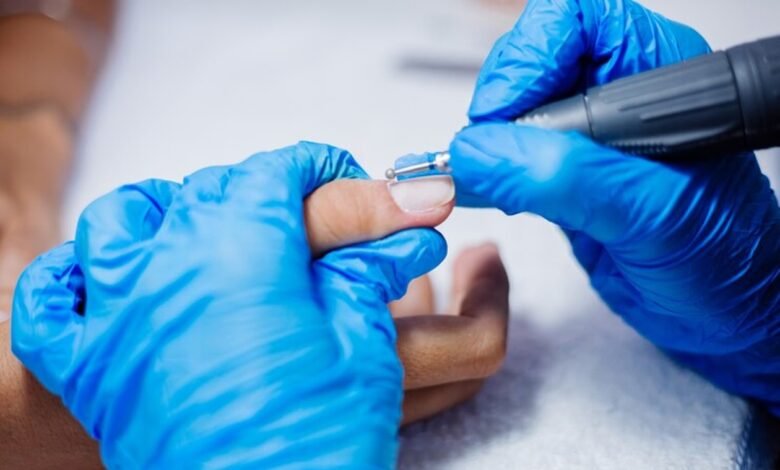How Do Fingernails and Toenails Grow? A Comprehnsive Guide

Fascinating in their functionality and appearance, fingernails and toenails are more than just cosmetic elements; they play a crucial role in our daily lives. The process of nail growth is a complex journey involving various stages and influenced by numerous factors. Understanding how fingernails and toenails grow is essential not only for their aesthetic maintenance but also for comprehending the significance of nail health in our overall well-being.
Fingernails and Toenails Grow
Nails, composed of a sturdy protein known as keratin, are more than mere extensions of our fingertips and toes. They act as protective shields, contributing to tactile sensitivity and aiding in delicate tasks. This comprehensive guide delves into the intricate process of nail growth, encompassing the factors influencing it, the differences between fingernails and toenails, and the measures necessary to maintain healthy and resilient nails for both functional and aesthetic purposes. Understanding this journey sheds light on the importance of proper care and hygiene practices for optimal nail health.
Importance of Nails
Nails play a vital role in our daily lives, serving more than just an aesthetic purpose. These tough coverings at the tips of our fingers and toes are composed of a sturdy protein called keratin. Apart from their role in enhancing the appearance of our hands and feet, nails offer crucial protection to the fingertips and toes, aiding in gripping and providing sensitivity.
Fingernails, in particular, help in performing delicate tasks, such as typing, writing, or picking up small objects. Additionally, nails act as a protective layer for the soft tissues of our fingertips, preventing injuries and promoting dexterity.
Moreover, nails can often reflect one’s overall health. Changes in the appearance or texture of nails might indicate certain deficiencies or underlying health conditions. Maintaining healthy nails through proper care and hygiene is essential not only for appearance but also as an indicator of one’s well-being.
An Overview of Fingernails and Toenails
Fingernails differ from toenails not only in size but also in their growth rate and structure. Learning about these distinctions provides insight into their growth patterns.
Nail Anatomy and Structure
Composition of Nails
Nails consist of keratin, the same protein found in hair. The nail structure includes the nail plate, nail bed, cuticle, and matrix.
Growth Phases
Understanding the growth phases – anagen, catagen, and telogen – helps comprehend the intricate process of nail growth.
Read More: What Causes Understanding Ingrown Toenails?
Factors Influencing Nail Growth
Nail growth is influenced by various factors, and understanding these elements can help in promoting healthier and stronger nails.
Genetics and Hereditary Aspects
Genetics play a significant role in determining the strength and speed of nail growth. Different individuals may have varying rates of nail growth due to their genetic makeup. Some people naturally have stronger, faster-growing nails, while others may experience slower growth due to genetic predispositions.
Diet and Nutrition
A well-balanced diet rich in essential nutrients, such as proteins, vitamins, and minerals, contributes to healthy nail growth. Nutrients like biotin, vitamin C, and iron play a crucial role in maintaining the health and strength of nails. Adequate hydration is also essential for the overall health of nails.
Hygiene and Care Practices
Proper nail care and hygiene are vital factors influencing nail growth. Regular trimming and shaping, moisturizing, and protecting nails from harsh chemicals or excessive exposure to water can significantly impact their growth and strength. Additionally, avoiding habits like biting nails or using nails as tools can prevent damage and promote healthier growth.
Understanding these factors and incorporating good practices can contribute to promoting optimal nail growth and maintaining the overall health of nails.
Understanding the Growth Process of Nails
The growth of nails is a fascinating and intricate process that occurs in a cycle of various stages. The primary parts involved in the growth process are the nail matrix and the nail bed.
The Nail Matrix
The nail matrix, situated beneath the cuticle at the base of the nail, is a crucial area where new cells are produced. These cells contribute to the formation of the nail plate, which is the visible part of the nail. The health and functioning of the nail matrix have a direct impact on the growth and overall quality of the nail.
Growth Rate and Patterns
Fingernails and Toenails: Nails grow at varying rates depending on multiple factors, such as age, health, and even the time of the year. Typically, fingernails grow faster than toenails, and nails on the dominant hand tend to grow more rapidly. On average, nails grow about 1/8 inch per month, but this can fluctuate due to numerous individual factors.
The growth of nails isn’t uniform; it occurs in phases. The anagen phase is the active growth phase, followed by the catagen and then the telogen phase, where the nail growth slows and eventually stops. Understanding these phases aids in comprehending the growth cycle and duration of each nail.
Differences Between Fingernails and Toenails
Fingernails and Toenails: Fingernails and toenails differ not only in size and growth rates but also in thickness and curvature. Fingernails are generally thinner and grow more rapidly compared to toenails. The growth patterns and the structure of the nail bed also differ, affecting their overall growth and durability.
Understanding the growth process of nails helps in comprehending their complexities and assists in taking proper care to maintain healthy and strong nails.
Common Nail Health Issues
Conditions Affecting Growth
Fingernails and Toenails: Various health conditions can impact nail growth, leading to brittleness, discoloration, or deformities.
Maintaining Healthy Nails
Adopting good nail care practices and lifestyle choices can help prevent common nail issues and promote overall nail health.
Debunking Nail Growth Myths
Myths and Misconceptions
Fingernails and Toenails: Numerous myths surround nail growth, which can mislead individuals seeking to improve their nail health.
Scientific Truths
Understanding the scientific realities behind nail growth helps dispel myths and provides clear guidance for effective nail care.
Lifestyle and Nail Health
Impact of Lifestyle Choices
Fingernails and Toenails: Lifestyle choices, including diet, stress levels, and exposure to chemicals, significantly influence nail health.
Tips for Enhancing Nail Growth
Simple lifestyle adjustments can positively impact nail growth, such as maintaining hydration, avoiding harsh chemicals, and using protective gloves.
Nail Care and Maintenance
Proper Nail Care Practices
Fingernails and Toenails: Regular trimming, filing, moisturizing, and protecting nails from harsh chemicals are key to maintaining healthy nails.
Recommended Tools and Methods
Utilizing proper tools and techniques for nail care ensures effective maintenance and reduces the risk of damage.
Read More: 9 Fish Oil Beauty Hacks to Try for Healthy Skin
Conclusion
Understanding the growth of fingernails and toenails is essential for maintaining their health and vitality. Nails, made primarily of keratin, are more than just adornments. They provide protection and aid in delicate tasks while reflecting aspects of our overall health.
The factors influencing nail growth, including genetics, nutrition, hygiene, and care practices, play crucial roles in determining the strength and speed of nail growth. Appreciating these factors empowers individuals to adopt practices that promote healthier nails.
The growth process of nails, regulated by the nail matrix and nail bed, follows distinct phases that influence their rate of growth and quality. Recognizing these phases and the differences between fingernails and toenails helps in understanding the complexities of their growth patterns.
To maintain healthy and vibrant nails, it’s imperative to adopt good hygiene practices, balanced nutrition, and debunk common myths surrounding nail care. By incorporating these practices, one can contribute to promoting optimal nail health and resilience.
In essence, the journey of nail growth is an intricate and dynamic process affected by various internal and external factors. By understanding and implementing appropriate care and practices, individuals can
FAQs
1. What is the average rate of nail growth?
The average rate of nail growth varies but typically amounts to about 1/8 inch per month. However, this rate can be influenced by factors such as age, health, and individual genetics.
2. How do genetics affect nail growth?
Genetics play a significant role in determining the strength and speed of nail growth. Individuals inherit varying rates of growth, influencing the quality and growth patterns of their nails.
3. Can nail polish impact the growth of nails?
Nail polish doesn’t directly affect the rate of nail growth, but excessive use of certain nail products and harsh chemicals might weaken nails, making them prone to breakage.
4. What are some signs of unhealthy nails?
Signs of unhealthy nails may include discoloration, brittleness, ridges, or changes in shape. Any sudden, noticeable change in the appearance of nails might indicate an underlying health issue.
5. Are supplements effective for improving nail growth?
Some supplements, particularly those containing biotin, can aid in enhancing nail health. However, it’s essential to consult with a healthcare professional before starting any new supplements to ensure they are suitable and safe for individual use.







